Moderation is ongoing with significant concerns over Omicron in an increasing number of regions (Monthly Global Trade Monitor – December 2021)
This analytics article utilizes trade data published by IHS Markit Global Trade Atlas (GTA) delivered via the new integrated trade data tool Global Trade Analytics Suite (GTAS)
Key Observations
- We can now report the complete data for the first three Qs of 2021; relative to 2020, export increased the fastest yoy in India (+43.8) followed by Brazil (+36.9%) and Russia (+36.7%); the growth rates surpassed 30.0% as well in the case of China (+32.7%) and Canada (+30.0%); the growth rates were above of 20.0% in all remaining economies (including +23.2% in the US and +20.7% in the EU), apart from the UK (+17.7% yoy)
- The sectors with the highest growth yoy in Q3 2021 were tin and articles thereof, railway or tramway locomotives, rolling stock, and iron and steel
- The adjusted PMI new exports orders readouts for the global manufacturing industry in November 2021 were above the benchmark value of 50.0 points (51.37) the 15th month in a row proving the sustained nature of recovery
- Transport costs are still at the highest levels; they moderated a bit in comparison to November on some routes; supply chain disruptions are likely to persist well into H1 2022
- The emergence and global spread of the Omicron variant is a significant concern; the number of states reintroducing stricter contingency measures is increasing fast, and that will impact global economic activity in Q1 2022; we already see a hike in the number of cases with the critical parameter to be observed is the number of hospitalizations (and related new deaths) and the vital importance of the overall vaccination rates
- Despite the above, world real GDP is projected by IHS Markit to increase by 5.6% in 2021 and 4.3% in 2022. The growth rates are expected to vary between 5.0% (3.9% in 2022) for advanced, 6.6% (4.9%) for emerging, and 4.0% (4.8%) for developing states; in Q1 2022, the global GDP should increase by 4.2%
- Exports are growing in all the top 10 states from March 2021 onwards, with the situation in the first two months of 2021 more nuanced; imports, in turn, started growing in all the states a month earlier (Feb 2021) apart from the UK, which showed negative growth rates both in January and February and once again in September
- The growth rates reported by the top 10 reached the peak in Q2 and then moderated to lower levels in Q3 and further in Q4 202
- We can now report the complete data for the first three Qs of 2021; relative to 2020, export increased the fastest yoy in India (+43.8) followed by Brazil (+36.9%) and Russia (+36.7%); the growth rates surpassed 30.0% as well in the case of China (+32.7%) and Canada (+30.0%); the growth rates were above of 20.0% in all remaining economies (including +23.2% in the US) and +20.7% in the EU, apart from the UK (+17.7% yoy)
- The highest yoy growth rates were observed in India in April 2021, both in exports (+201.8% yoy) and imports (+169.1% yoy), the country most adversely affected in April 2020; the base effect is thus apparent and must be taken into account in the correct interpretation of the data
- The average growth rate for the top 10 economies reached its peaks in April 2021 for exports and May 2021 for imports and are higher for imports ever since, which is indicative of solid internal demand and strong consumer confidence
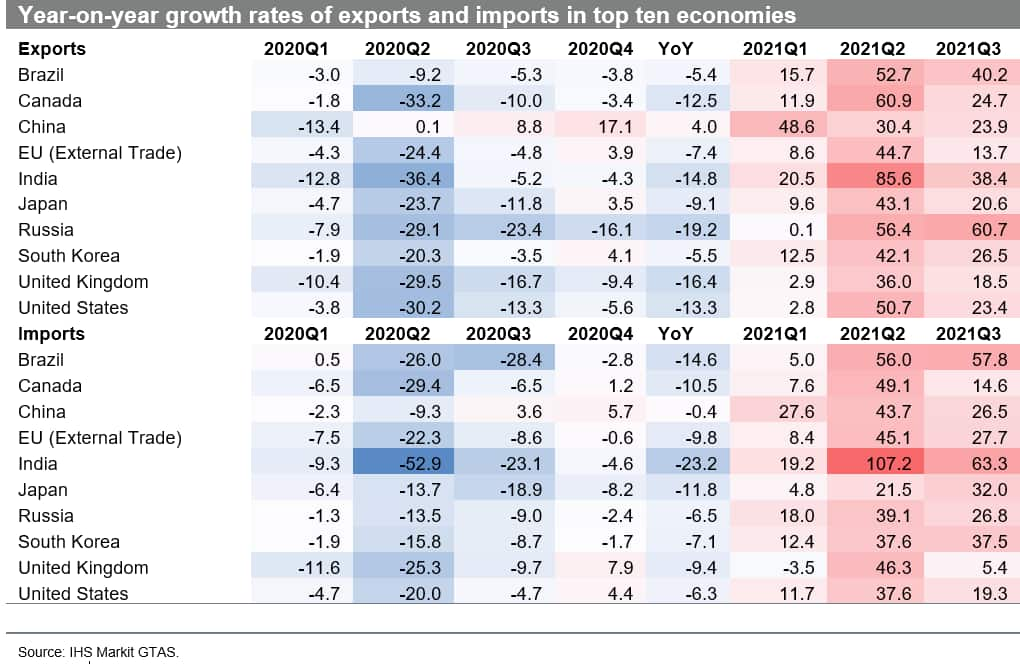
- Four states have already reported data for November 2021 - Brazil (+17.0% yoy in exports), China (+21.5%), South Korea (+32.0%), and Japan (only +10.8%); the growth rates are positive but lower than observed in the preceding months (peak of the recovery) for China and Brazil, in line with our earlier expectations, but improved on prior month for South Korea and Japan
- The growth rate of Chinese exports in November 2021 was the lowest since the beginning of the year (apart from July)
- If we compare the nominal value of exports to the last month preceding the global pandemic (Dec 2019), we see that in October - November 2021, all states reported higher export levels than in December 2019; among the top 10, China recovered the fastest; among countries that reported data for November, China (mainland) and South Korea still recorded the highest levels in relative terms with the position of Brazil deteriorating fast
The full version Table with monthly breakdown is available to our Global Trade Analytics Suites (GTAS) clients only on Connect platform. Contacts IHS Markit Customer Care Customer.Care@ihsmarkit.com for details
Sectoral perspective
- The recovery in the top ten exports in Q3 2021 is present in nearly all the sectors except for tobacco, oilseeds, furskins, special yarns and wadding, nickel and product thereof and foremost made-up textiles (negative yoy growth rates in Q2, the commodity group seems to behave countercyclically).
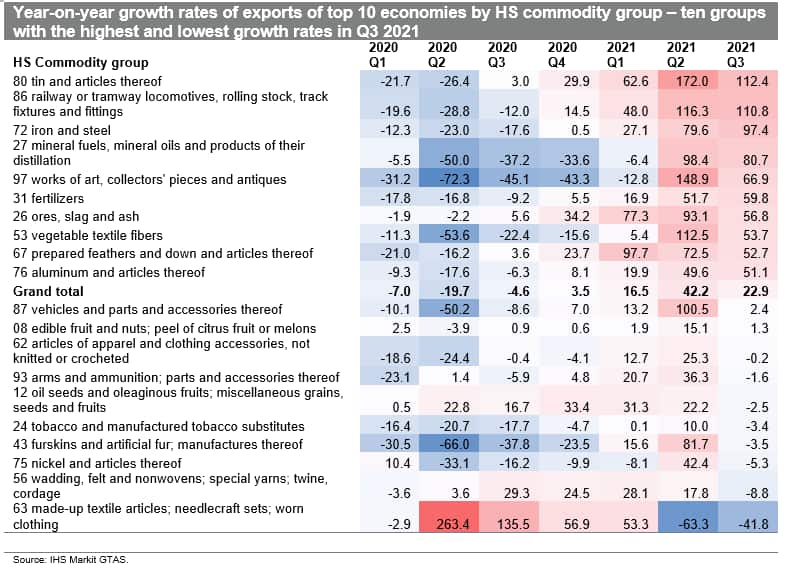
The full version Table with monthly breakdown for all HS2 codes is available to our Global Trade Analytics Suites (GTAS) clients only on Connect platform. Contacts IHS Markit Customer Care Customer.Care@ihsmarkit.com for details
- The sectors with the highest growth yoy in Q3 2021 were tin and articles thereof, railway or tramway locomotives, rolling stock, and iron and steel
- Vehicle industry, one of the sectors with the highest growth rate in Q2, grew only by 2.4% yoy in Q3
- Overall, in comparison to Q2, yoy growth rates in Q3 decreased in 84 commodity groups and increased only in 12
- Overall, Q4 2020 brought a general recovery (+3.5% yoy), and Q1 2021 generated the foreseen boost to top 10 exports (+16.5% yoy), followed by even more impressive growth in Q2 2021 (+42.2% yoy). As was expected, the growth rate moderated to +22.9% in Q3, and we expect further moderation in Q4 2021 and Q1 2022O
Prospects for the Forthcoming Months
COVID-19
- The overall impact of COVID-19 on global trade and the global economy depends on the duration, severity, and uneven spatial and temporal distribution of the pandemic (changing with the subsequent waves of the pandemic) and the associated severity containment efforts taken by individual states. The health crises create problems both on the supply side (e.g., due to lockdowns, forced production stoppages, disrupted global value chains) and demand-side (e.g., lower consumer confidence, delayed consumption, lower incomes)
- On 26 November 2021, WHO designated a new SARS-Cov-2 variant B.1.1.529 as a variant of concern, named Omicron, on the advice of WHO's Technical Advisory Group on Virus Evolution. This decision was based on the evidence that Omicron has several mutations that may have an impact on the speed of spread, higher transmitability, or the severity of illness it causes; the markets reacted strongly to the new adverse information with an increasing number of states reintroducing stricter contingency measures
- The full impact of Omicron will be known only within several weeks when we will understand the severity of the mutation. Nonetheless, it is likely to impact global economic activity in Q1 2022; the variant potentially could become a game-changer
- The cumulative number of confirmed cases of COVID-19 globally by 1 January 2022 reached 289.3 million and 5.45 million deaths
- The 2-week moving averages of global new cases globally started to rise again by the end of October 2021, with global average death rates following with no apparent delay, the Omicron led to the highest number of new cases reported since the outbreak of the pandemic in the last week of 2021, with no immediate impact, yet, on the number of Covid-19 related deaths
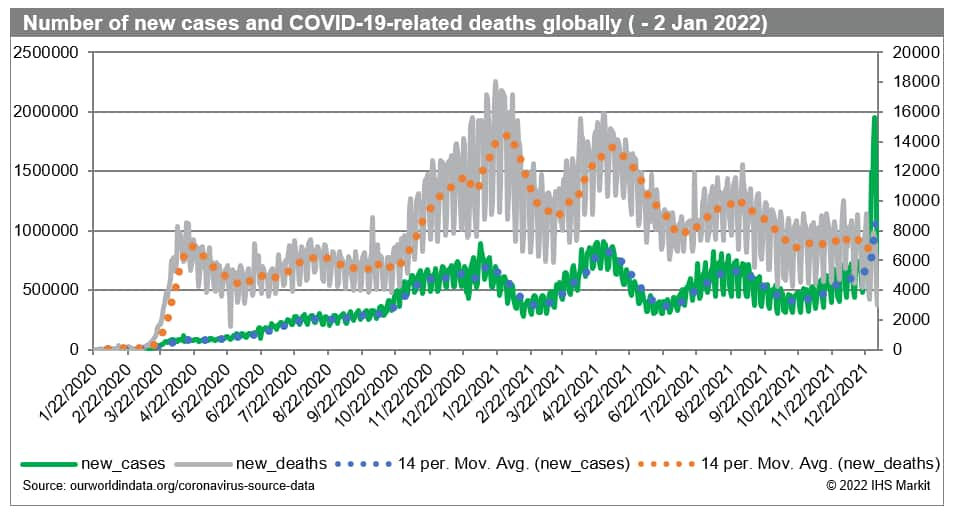
- The reported number of vaccinations globally reached 8.81 billion with 3.77 billion people fully vaccinated (with two doses or equivalent one dose), which is equal to 48.3% of the global population; to boost immunity to the new variant, an increasing number of countries, primarily advanced, started to distribute the third booster dose while Israel began to distribute the fourth dose
- The adjusted PMI new exports orders (PMI NExO) readouts for the global manufacturing industry in November 2021 were above the benchmark value of 50.0 points (51.37) the 15th month in a row proving the sustained nature of recovery and still pointing to a positive short-term outlook for global trade; in comparison to Oct readouts, they were higher by 0.76
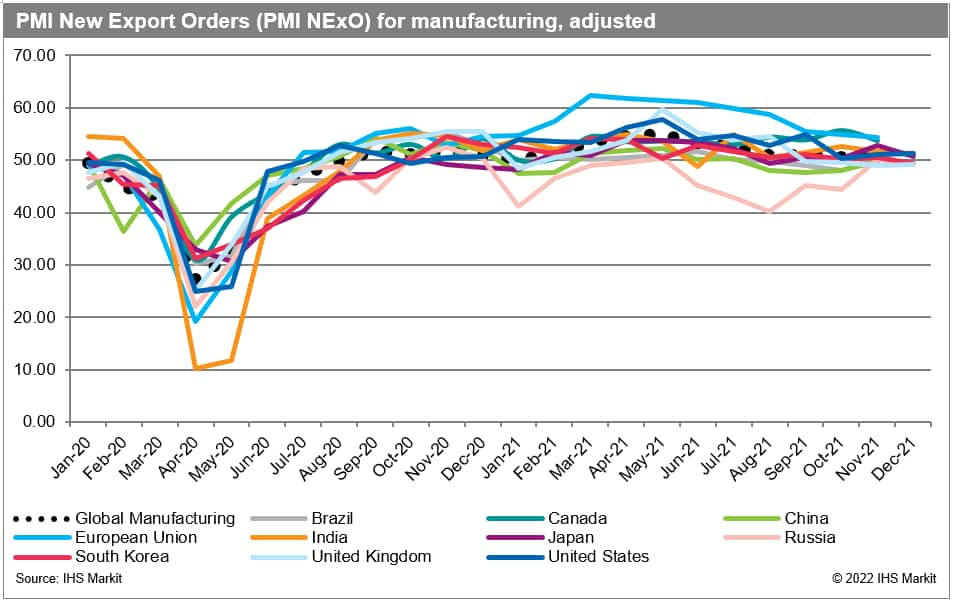
- The values for November were pointing to a positive short-term outlook for exports in eight out of the top 10 economies with the highest importance for the EU (54.42), Canada (53.65), Japan (52.78), India (51.73) above the global average); the values were below of 50.0 for the UK (49.00) & China (49.85); Russia scored a result above of 50.0 for the first time in 11 months
- Month on month PMI NExO deteriorated the most in the US and increased the most in the case of Canada & India
- PMI NExO in November 2021 for global manufacturing (50.60) and global services (51.44) were above the 50.0 points benchmark (49.31); PMI NExO for global services went up month-on-month for the second time in a row
- Transport costs are still at very high levels, adversely affecting global trade flows. It is due to 6-7-year highs in crude oil and natural gas prices (partially eased in some regions, apart from Europe), excessive port congestion in many parts of the world, and COVID-19 related contingency measures taken by states affecting the productivity of ports and global logistic chains in general
- The composite index of freight costs by the Shanghai Shipping Exchange moderated to 3344 points (USD/TEU) by the last week of December, thus going up by 3.0% m/m and 1.3% w/w. It can moderate a bit after the Christmas/New Year season and in the Q1 of 2022; Month-on-month it increased the most on routes to Southeast Asia, Korea, and East Coast of America, and fell the most on routes to South Africa, W/E Africa & Europe
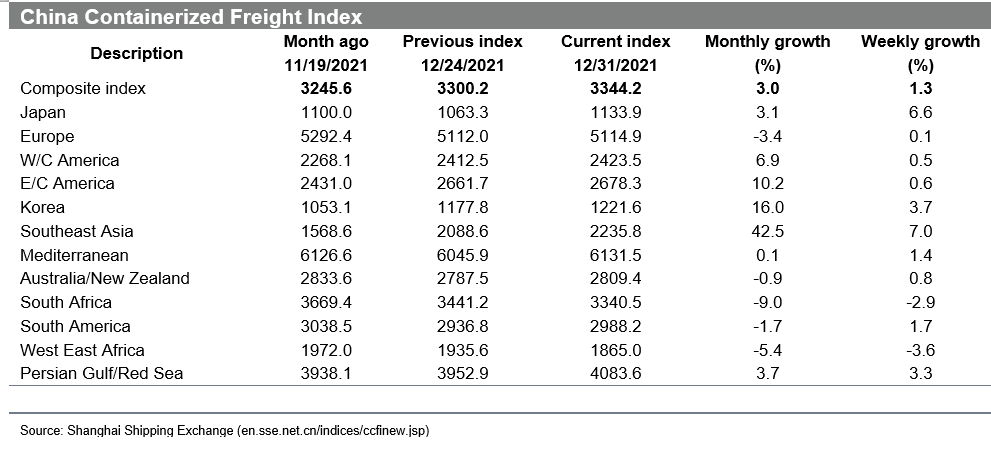
Real GDP forecasts
- The most recent real GDP growth forecasts from IHS Markit were published on 15 December 2021 and are based on the baseline scenario of the impact of COVID-19 on the global economy (they did not incorporate the Omicron outbreak)
- After a 3.4% decline in 2020, world real GDP is projected to increase 5.6% in 2021 and 4.3% in 2022. The growth rates are expected to vary between 5.0% (3.9% in 2022) for advanced, 6.6% (4.9%) for emerging, and 4.0% (4.8%) for developing states; the growth rates are still predicted to moderate to around 3% in 2026
- IHS Markit ECR team stresses that the global economy made the transition from recovery to expansion in 2021 amid ongoing turbulence from the COVID-19 pandemic. An uneven economic expansion generated supply/demand imbalances, leading to major supply chain disruptions and rising inflation. In 2022, businesses will navigate multiple transitions in the global economy. These include the transition from pandemic to endemic COVID-19, the shift from fiscal policy stimulus to restraint, rising interest rates and tightening credit conditions, and a bumpy energy transition from hydrocarbons to renewables. Amid these transitions, global economic growth will likely slow in 2022, as some major economies approach or reach full employment.
- The now estimated growth rate in Q1 2021 was 3.5%. In Q2 2021, real global GDP is estimated to have grown by 11.7%, with the growth impulse stronger for advanced (12.5%) than emerging economies (10.5%). In Q3 growth rate moderated to 4.6% globally (4.3% and 5.2% respectively) and is going to moderate further in Q4, reaching 4.0% globally (4.6% for advanced and 3.2% for emerging economies); the growth rate for Q1 2022 is expected to be 4.2% and be higher in advanced states (4.7%) than in emerging economies (3.5%); starting from Q2 2022, growth in emerging states should start continuously exceeding the growth in the group of advanced states thus catching-up is likely to occur
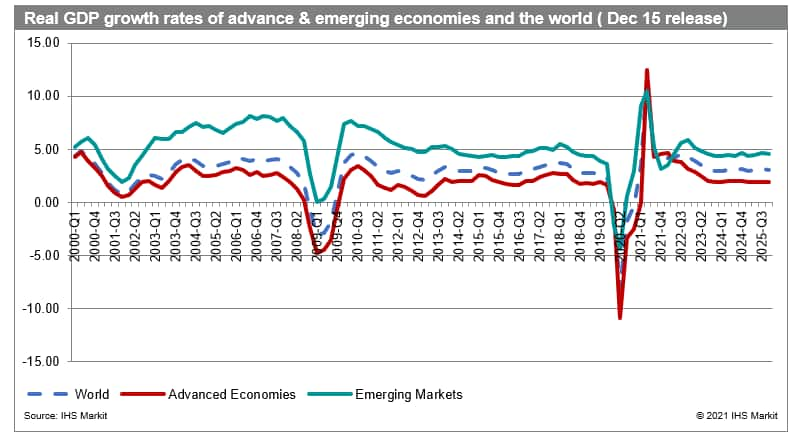
This column is based on IHS Markit Maritime & Trade Global Trade Analytics Suite (GTAS) data. The full version of the article is available for our clients on Connect platform.
For more details about GTAS, please visit the product page
https://ihsmarkit.com/products/maritime-global-trade-analytics-suite.html